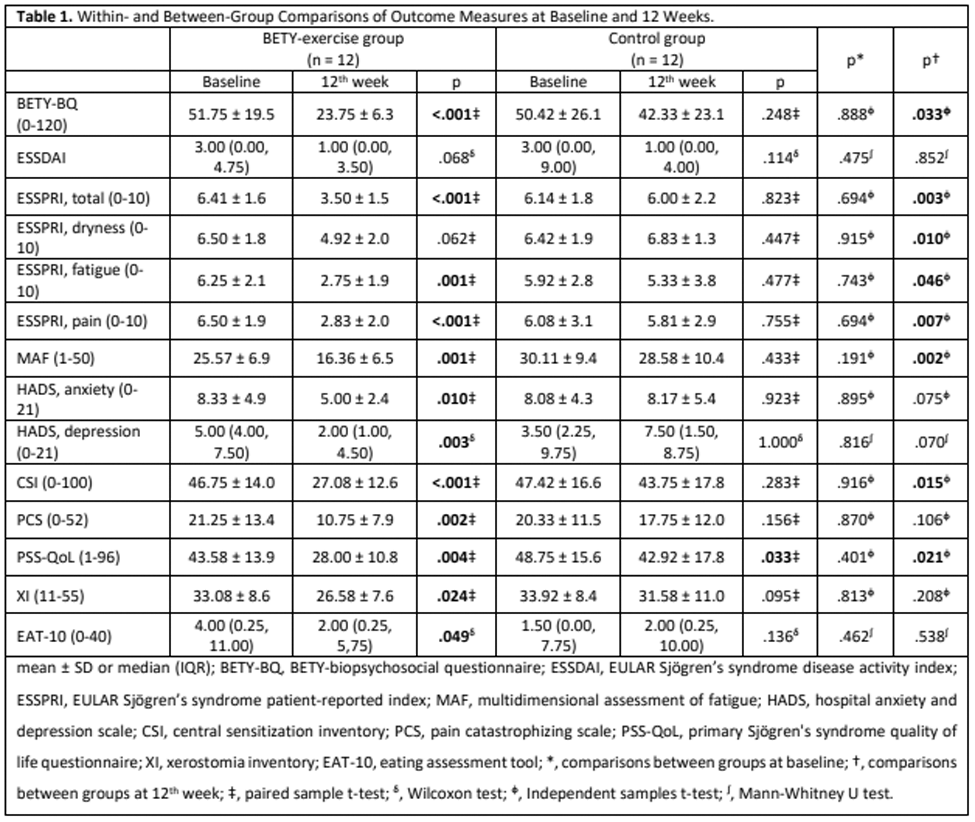

Background: Primary Sjögren’s syndrome (pSS) is a systemic autoimmune disease characterized by dryness, chronic pain, fatigue, sleep disturbances, and psychological symptoms such as anxiety and depression. These clinical features highlight the need for a comprehensive biopsychosocial approach to disease management. The Cognitive Exercise Therapy Approach (Bilişsel Egzersiz Terapi Yaklaşimi-BETY) is a biopsychosocial-based therapeutic exercise method. While the effectiveness of BETY has been demonstrated in various rheumatic diseases [1, 2], its impact on patients with pSS remains unclear.
Objectives: This study aimed to evaluate the effectiveness of a 12-week biopsychosocial-based exercise intervention in improving clinical outcomes in patients with pSS.
Methods: A total of 24 females with pSS were randomly allocated to two groups: a BETY-exercise group (n=12) or a control group receiving only treatment as usual (n=12). The BETY is a biopsychosocial-based exercise model focusing on function-oriented core stabilization exercises, integrating chronic pain and mood management with physical exercises. The intervention was delivered three times per week for one hour over 12 weeks. Assessments were conducted at baseline and the 12th week. The primary outcome measure was the BETY-biopsychosocial questionnaire (BETY-BQ). Secondary outcomes included the EULAR Sjögren’s syndrome disease activity (ESSDAI), EULAR Sjögren’s syndrome patient reported index (ESSPRI), multidimensional assessment of fatigue (MAF), hospital anxiety and depression scale (HADS), central sensitization inventory (CSI), pain catastrophizing scale (PCS), quality of life in pSS (PSS-QoL), xerostomia inventory (XI), and eating assessment tool-10 (EAT-10).
Results: The characteristics of patients (age, BMI, duration of diagnosis, educational level, ESR, and CRP) and baseline outcome measures were similar between groups (p > 0.05). The BETY-exercise group showed significant improvements in BETY-BQ, ESSPRI (total, fatigue, and pain), MAF, HADS (anxiety and depression), CSI, PCS, XI, and EAT-10 scores (p < 0.05), while no significant changes were observed in the control group (p > 0.05). PSS-QoL scores improved significantly in both groups (p < 0.05). At week 12, between-group differences were significant for BETY-BQ, ESSPRI, MAF, CSI, and PSS-QoL (p < 0.05) (Table 1).
Conclusion: A 12-week BETY exercise intervention significantly improves clinical outcomes in patients with pSS. These findings support the potential clinical utility of biopsychosocial-based exercise programs in the management of pSS. Further long-term studies with larger sample sizes are needed to confirm these benefits and assess the sustainability of the effects.
REFERENCES: [1] Karaca NB, Ünal E, Karakaya J, Kalyoncu U, Kiraz S. Effectiveness of a supervised group exercise therapy based on the biopsychosocial model introduced simultaneously with anti-TNF therapy in anti-TNF-naive patients with active ankylosing spondylitis. Turkish Journal of Medical Sciences 2022;52(3):667-76.
[2] Tüfekçi O, Ünal E, Aktaş BE, et al. Do functionality, strength, vascularization, inflammatory and biopsychosocial status improve by biopsychosocial model-based exercise in SSc? Rheumatology. 2024.

Acknowledgements: NIL.
Disclosure of Interests: None declared.
© The Authors 2025. This abstract is an open access article published in Annals of Rheumatic Diseases under the CC BY-NC-ND license (